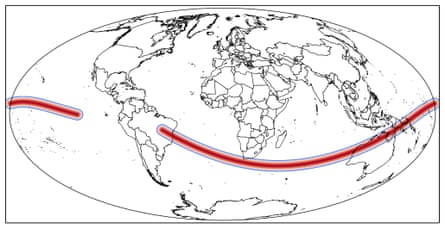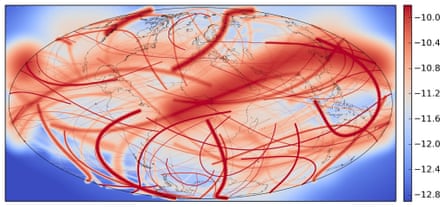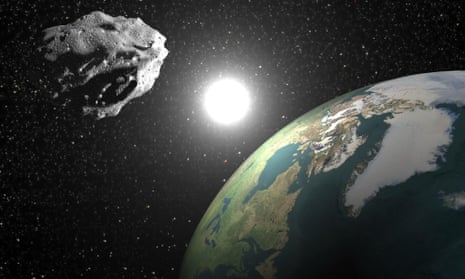The aim of Asteroid Day is to inform the public and raise awareness about the possibility that asteroids can collide with the Earth in the future. Today was chosen to highlight the risk because on the same day in 1908, a 30m object entered the atmosphere over a forested region in Siberia and exploded in mid-air. The resulting shockwave and heat levelled the forest over an area larger than greater London.
About twice a year an asteroid causes an explosion in the atmosphere that releases the energy equivalent of the Hiroshima nuclear bomb. On occasion, you can see asteroid hits first hand in the night sky when a shooting star leaves a bright streak against the starry background. A shooting star is typically only a grain-sized particle that burns up in the atmosphere, but it is the same mechanism as a larger scale asteroid collision, only with fewer consequences. Asteroids are part of our natural environment and we have lived with them as long as we have existed.
Even though there is a regular influx of cosmic material to the Earth, an asteroid impact only rarely causes damage. Usually, asteroids are too small, explode too high or enter the atmosphere over uninhabited territory such as the ocean. However, in time intervals that can be measured in tens or even hundreds of years, an asteroid impact causes significant damage.
A relatively small impact event occurred over the Russian city of Chelyabinsk in 2013. Here, a 17 metre object caused a shock wave that shattered windows and injured about 1500 people. Impacting asteroids can measure hundreds of metres in diameter and have the potential to cause substantial damage to our civilisation. Such an event may lie many years in the future, but the damage that could be caused is reason enough to research asteroids and learn about their potential for natural disaster.
In contrast to other natural disasters, such as earthquakes, an asteroid impact is predictable. Shortly after an asteroid is discovered, its impact probability and time can be calculated to the hour, even if the potential impact is tens of years in the future. In addition, the impact location can be predicted to lie within a so-called “impact corridor”, as shown in the image below. Because of uncertainty in the observations of asteroids, the impact prediction does not produce a point but a corridor that typically stretches across half the globe.

To make use of the fact that asteroid impacts are predictable, an asteroid needs to be discovered before it impacts the Earth. But at the moment, we have only discovered about 1% of the asteroids that can impact the Earth in the future. This means the next asteroid impact will likely happen without warning, as happened in Chelyabinsk. What we need now are capable telescopes to help us discover all potentially threatening asteroids.
Space-based telescopes, such as the Sentinel mission proposed by the B612 Foundation, or Nasa’s proposed NeoCam mission, would be able to discover most of the remaining asteroids within 10 years. Such telescopes would also help reduce uncertainty in the observational data. Less uncertainty means that we can make a clearer statement about whether or not an asteroid is likely to strike Earth. Similarly, better observations narrow the impact corridors, and allow us to make better predictions about where a potential impact might occur.
Considering the entire asteroid population, and averaging over many years, any region on Earth has an equal likelihood of being struck by an asteroid. The average impact distribution can be likened to a pile of many transparent, sharp images stacked above each other. Stacked in this way, the sharp images produce a blurred picture with little distinguishable information. But taken by themselves, each individual image represents the day-to-day knowledge of where an asteroid impact is most likely to occur. One such snapshot is shown below:

The current knowledge of asteroid impact probability distribution changes over time because new observations improve our knowledge. But information like this can help disaster planning because it is our current best guess of where an asteroid might strike. Usually, impact probabilities are low, similar to winning the jackpot in the lottery. This is the daily situation that we live with, and not very worrisome. However, some asteroids stand out. In 2004, the asteroid Apophis had a 3% probability of striking Earth in the year 2029. In such a scenario, it is important to know where the impact can occur and what the consequences might be.
To support decision-making around the asteroid threat, researchers at the University of Southampton have developed software called ARMOR (Asteroid Risk Mitigation Optimization and Research tool) which can predict the impact sites of asteroids and the effects those strikes may have. The figures shown here are results from this research, which was presented to world experts at the Planetary Defense Conference in April 2015.
An asteroid impact can be averted by altering the trajectory of an asteroid. Our long- term goal is to support the design of these missions by providing knowledge of where an asteroid might hit and what damage it could cause.
Asteroids are part of our natural environment. Smaller pieces of material collide with the Earth on a regular basis. Typically, a shooting star is the result, but a large asteroid impact can cause damage on a global scale. Telescopes are the next step to enable further investigation of this natural hazard. Early observations make it possible to predict the impact location and even enable deflection of the asteroid to avert an impact. We are not in a critical situation at the moment, and the continued effort of the dedicated planetary defence community aims to ensure that we are prepared when the next Tunguska asteroid is discovered.
